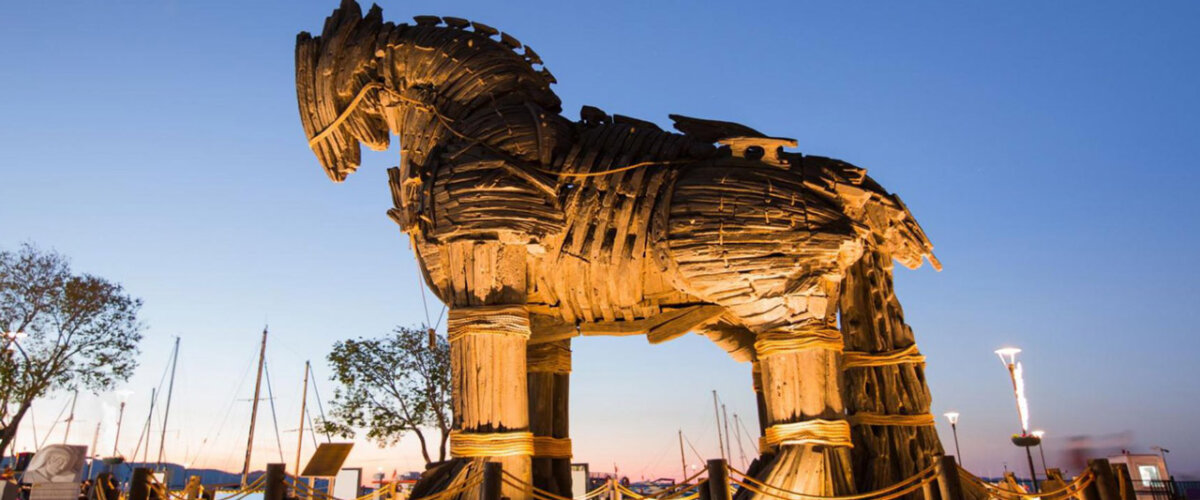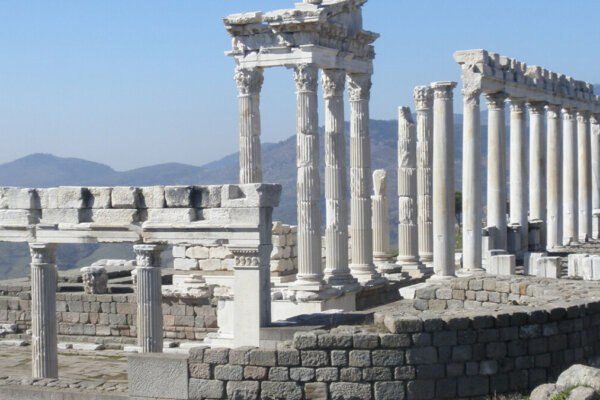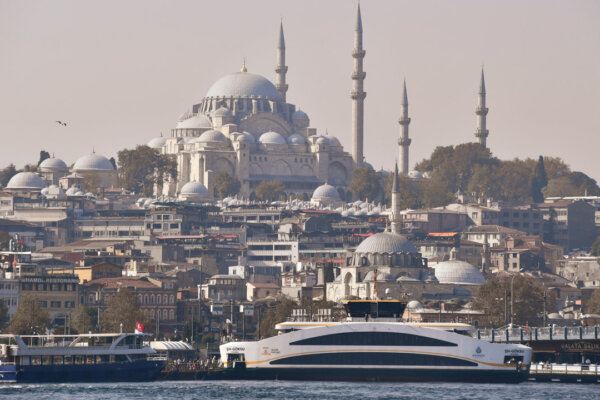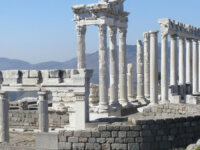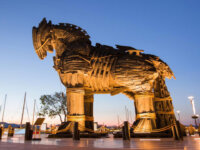TURKEY – Nestled at the foot of Mount Ida, the ancient city of Troy is a captivating destination near Canakkale. This historical gem has earned its place on the UNESCO World Heritage List in 1998 under the name “Ancient City of Troy,” serving as a testament to thousands of years of history.
According to Homer’s epic poem, the Iliad, Troy was a city of immortality and played a significant role in the Trojan War. Its ruins, which can still be seen today, are a fascinating glimpse into the past and offer a unique opportunity for visitors to step back in time.
The city of Troy has a rich and complex history, with evidence of human settlement dating back to the Early Bronze Age. It was a thriving trade center and a strategic location for various civilizations, including the Greeks, Romans, and Ottomans.
Today, visitors can explore the remains of the ancient city, including the famous Trojan Horse, which has become an iconic symbol of the Trojan War. The archaeological site also features impressive walls, temples, and other structures that provide insight into the daily life of the people who once inhabited this legendary city.
In addition to its historical significance, the ancient city of Troy also boasts stunning natural surroundings. The nearby Mount Ida offers breathtaking views and is believed to be the birthplace of Greek mythology’s gods and goddesses.
Overall, the ancient city of Troy is a must-visit destination for history buffs, archaeology enthusiasts, and anyone looking to immerse themselves in the rich culture and heritage of Turkey. Its inclusion on the UNESCO World Heritage List only adds to its allure and solidifies its status as a truly remarkable and timeless destination.
Legendary Troy
Troy, also known as Troia, boasts a rich history intertwined with the legendary Trojan War and the iconic Trojan Horse. Located strategically on the trade route between Europe and Anatolia, the city of Troy has endured numerous natural disasters and wars throughout its existence.
Having been destroyed and rebuilt nine times, the city still bears the marks of its diverse architectural structures, narrating tales of resilience and transformation. The ruins of Troy are a testament to the enduring spirit of its people who have persevered through countless challenges.
The Trojan War, which is believed to have taken place in the late Bronze Age, is one of the most famous events in Greek mythology. It was a ten-year-long conflict between the Greeks and the Trojans, sparked by the abduction of Helen, the wife of Menelaus, by Paris, the prince of Troy. This epic war has been immortalized in various literary works, including Homer’s Iliad and Virgil’s Aeneid.
https://www.instagram.com/p/BfUFzUAF611/
Another significant aspect of Troy’s history is the Trojan Horse, a wooden horse used by the Greeks to enter the city and defeat the Trojans. This ingenious tactic has become a symbol of deception and trickery, and it continues to be referenced in popular culture today.
Apart from its mythical associations, Troy was also a thriving city with a bustling economy. Its strategic location made it a hub for trade and commerce, attracting merchants from all over the Mediterranean region. The city’s prosperity can be seen in the remains of its grand buildings, such as the impressive city walls, temples, and palaces.
However, Troy’s prosperity was not without its challenges. The city faced numerous natural disasters, including earthquakes and floods, which caused significant damage to its structures. In addition, it was also involved in several wars, including conflicts with neighboring cities and invasions by foreign powers.
Despite these adversities, Troy managed to rise from the ashes time and again, rebuilding itself and reclaiming its position as a prominent city in the region. Today, the ruins of Troy are a popular tourist destination, attracting visitors from all over the world who come to witness the remnants of this legendary city and learn about its fascinating history.
In conclusion, Troy’s legacy goes beyond its association with the Trojan War and the Trojan Horse. It is a testament to the resilience and endurance of its people, who have left behind a rich cultural heritage that continues to intrigue and inspire us today.
Things to Do in Troy: Top Attractions
Troy, the name of the city from the Bronze Age and the site of the famous Trojan War, holds a prominent position in ancient Greek mythology and literature.
The archaeological excavations at the site in Northwestern Asia Minor (present-day Turkey) have revealed a prosperous city that flourished over many centuries. The city was strategically located on the coast of the Aegean Sea, making it an important trading hub for the region. Its strategic location also made it a target for conquest by various civilizations throughout history.
According to legend, Troy was founded by the mythical figure King Tros, after whom the city was named. It is believed to have been inhabited since the Neolithic period, with evidence of continuous settlement until its eventual destruction in the 12th century BC.
Troy’s fame reached new heights with the epic poem “The Iliad” by Homer, which tells the story of the Trojan War. This legendary conflict between the Greeks and Trojans has captured the imagination of people for centuries and has become a symbol of heroism, love, and tragedy.
The city of Troy has also been referenced in various works of literature, art, and music, cementing its place in popular culture. Its ruins, which were discovered in the late 19th century, continue to attract tourists and scholars alike, providing valuable insights into the ancient world.
In conclusion, Troy’s significance goes beyond just being the setting for a famous war. It represents a rich cultural heritage and serves as a reminder of the enduring impact of ancient civilizations on our modern world.
Gallipoli and Troy Tour
Explore the rich history of the region with tours of Gallipoli and Troy, providing detailed information about the ANZAC landing in World War I and the important historical sites of the Gallipoli Peninsula.
These tours offer the opportunity to visit war memorials that honor fallen soldiers and learn about the landscapes that witnessed historic battles. Visitors can gain a deeper understanding of the events that took place during the ANZAC landing and the impact it had on the region.
The Gallipoli tour takes visitors through the rugged terrain where the ANZAC forces fought against the Ottoman Empire. It includes stops at significant sites such as Anzac Cove, Lone Pine, and Chunuk Bair, where visitors can pay their respects and reflect on the sacrifices made by the soldiers.
In addition to the ANZAC landing, the tour also covers the broader history of the Gallipoli Peninsula, including its strategic importance in various conflicts throughout history. Visitors can learn about the ancient civilizations that once inhabited the area and the role it played in shaping the modern world.
The Troy tour offers a glimpse into the legendary city that has captured the imagination of people for centuries. Visitors can explore the ruins of the ancient city and learn about the Trojan War, one of the most famous battles in Greek mythology.
Both tours provide a unique opportunity to delve into the past and gain a deeper appreciation for the sacrifices and struggles of those who came before us. They offer a chance to connect with history and understand the significance of these sites in shaping the world we live in today. So come and discover the fascinating history of Gallipoli and Troy on these unforgettable tours.
Çimenlik Castle – Military Museum
Originally known as Kala-i Sultaniye, the Çimenlik Castle was built in 1462 by Fatih Sultan Mehmet. Over the years, it has served various purposes, from being a military fortress to a museum.
Today, the castle is home to an extensive collection of artillery, artifacts, and displays related to the naval victory on March 18, 1915. The museum was established in 1982 and showcases the significant historical significance of Çanakkale and the Dardanelles Strait.
The Çimenlik Castle is not only a popular tourist destination but also a symbol of the bravery and resilience of the Turkish people. It stands as a reminder of the sacrifices made during the Gallipoli Campaign, where thousands of soldiers lost their lives.
Visitors can explore the castle’s well-preserved walls and towers, which offer stunning views of the surrounding area. Inside, they can admire the impressive collection of weapons, uniforms, and other military equipment used during the Battle of Gallipoli.
One of the highlights of the museum is the replica of the Nusret mine layer, which played a crucial role in the Ottoman victory. Visitors can also see the original anchor of the British battleship HMS Goliath, which was sunk during the battle.
Aside from its military significance, the Çimenlik Castle also holds cultural importance. It hosts various events and exhibitions throughout the year, showcasing the rich history and traditions of Çanakkale.
In conclusion, the Çimenlik Castle is a must-visit for anyone interested in Turkish history and culture. It serves as a testament to the country’s past and a tribute to the brave soldiers who fought for their nation’s freedom.
The Trojan Horse: A Tale of Deception
The Trojan Horse, a legendary symbol of cunning strategy, played a crucial role in the famous Trojan War. The Greeks, unable to breach the strong walls of Troy, devised a clever plan.
They built a giant wooden horse and left it outside the city as an offering, seemingly harmless and pretending to sail away. The Trojans, believing they had won, brought the horse inside their walls.
Little did they know, Greek soldiers were hiding inside the hollow horse and emerged at night, signaling the return of the Greek army and leading to the downfall of Troy. This clever tactic is still referenced today as a prime example of strategic deception in warfare.
The Trojan Horse has become a timeless symbol of deceit and trickery, representing the power of outsmarting one’s enemies. It serves as a reminder that sometimes, the most unexpected and seemingly harmless things can be the most dangerous.
Furthermore, the story of the Trojan Horse also highlights the importance of being vigilant and not letting one’s guard down, even in times of apparent victory. The Trojans’ overconfidence and failure to thoroughly inspect the gift they received ultimately led to their defeat.
Overall, the legend of the Trojan Horse continues to fascinate and intrigue people, serving as a cautionary tale and a testament to the ingenuity of the human mind.
Kilitbahir Fortress: Guardian of the Narrows.
Located across from the Dardanelles Narrows in Çanakkale, the Kilitbahir Fortress was built by Sultan Mehmet II in 1452 and served as a formidable protector. Along with the Çimenlik Castle, it played a crucial role in safeguarding the strait from potential threats. The fortress offers a glimpse into the historical significance of the area.
Strategically positioned at the entrance of the Dardanelles, the Kilitbahir Fortress has a rich history dating back to the Ottoman Empire. It was originally constructed to defend against enemy attacks and control the movement of ships through the narrow waterway. Over the years, it has witnessed numerous battles and sieges, making it a symbol of strength and resilience.
The fortress is surrounded by thick stone walls and towers, giving it an imposing appearance. Inside, visitors can explore the various rooms and chambers, including the barracks, armory, and mosque. The main tower, known as the “Mehmetçik Tower,” offers panoramic views of the Dardanelles and the surrounding landscape.
In addition to its military significance, the Kilitbahir Fortress also holds cultural and architectural value. Its construction reflects the unique blend of Ottoman and Byzantine styles, showcasing the influence of both empires in the region. It has been well-preserved over the centuries, allowing visitors to step back in time and experience the grandeur of the past.
Today, the fortress is open to the public and serves as a popular tourist attraction. It is not only a must-see for history buffs, but also for anyone seeking stunning views and a deeper understanding of the region’s past. The Kilitbahir Fortress stands as a testament to the enduring legacy of the Ottoman Empire and its impact on the world.
Gallipoli Battlefield: A Scene of Remembrance.
The Gallipoli Campaign, a part of World War I, took place on the Gallipoli Peninsula from 1915 to 1916. This battlefield, now known as the Gallipoli National Park, serves as a solemn reminder of the sacrifices made during this historic conflict.
The area is home to trenches, war memorials, and well-preserved artifacts, attracting visitors to reflect on the events that unfolded here. The campaign was a significant military operation, with Allied forces attempting to capture the Ottoman capital of Constantinople (now Istanbul) by securing control of the Dardanelles strait. However, despite months of intense fighting, the Allies were unable to break through the Ottoman defenses.
The Gallipoli Campaign holds great significance for both Turkey and the countries involved in the conflict. For Turkey, it marks a turning point in their fight for independence and is seen as a symbol of national pride and heroism. For the Allied nations, it represents a tragic loss of life and a failed attempt to gain control of a strategic location.
Today, the Gallipoli National Park stands as a powerful memorial to all those who lost their lives during the campaign. It serves as a place for remembrance and reflection, where visitors can pay their respects to the soldiers who fought and died here. The preserved trenches and other remnants of the battle provide a glimpse into the harsh realities of war and serve as a reminder of the human cost of conflict.
In addition to its historical significance, the Gallipoli National Park also boasts stunning natural beauty. The rugged coastline, sandy beaches, and rolling hills make it a popular destination for outdoor enthusiasts and history buffs alike. Visitors can explore the various monuments and museums, take guided tours, or simply soak in the peaceful atmosphere of this hallowed ground.
Overall, the Gallipoli Campaign remains a poignant chapter in world history, and the Gallipoli National Park stands as a lasting tribute to the bravery and sacrifice of those who fought here. It serves as a reminder of the devastating consequences of war and the importance of remembering and honoring those who have given their lives in service to their country.
The Gallipoli campaign was launched to protect the Dardanelles, a crucial sea route leading to the Russian Empire. This strait connects the Aegean Sea and the Sea of Marmara, making it of immense strategic importance.
Established in 1973, the Gallipoli National Historical Park preserves the unique geographical location of the peninsula and its role as a historical bridge and barrier.
Immerse yourself in the rich tapestry of history, legends, and strategic significance as you explore the fascinating sites around Canakkale.
Whether walking through ancient ruins, reflecting on the struggles of war, or admiring the strategic importance of important fortresses, this area offers a journey through time unlike any other.

